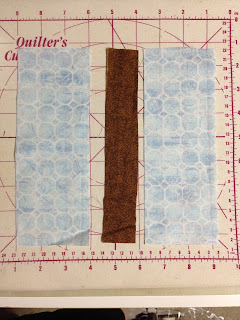Of all the the techniques that I have taught over the years, applique seems to stir fear in the hearts of my quilting students. Never have really understood why. Maybe it's the four-letter word - "hand." Applique is best known to be done by hand, but can also be achieved by machine.
Block 3 in our Neighborhood Sew Along has a sweet little bird sitting atop the roof singing a tune, I'm sure. To encourage you to give applique a try, I have a couple tips and will show a couple ways to achieve success.
Option 1 - Finished Edge Fusible Applique
 You will need Lightweight Fusible Interfacing and a pen or fine tipped marker. Trace the needed shapes on to fusible.
You will need Lightweight Fusible Interfacing and a pen or fine tipped marker. Trace the needed shapes on to fusible.
Next roughly cut apart pieces, placing them with coordinating fabric. Leave at least a 1/4" margin around all pieces
With right sides together (right side of fabric and bumpy-fusible side of interfacing) sew interfacing to fabric following drawn lines. Cut out shapes leaving a narrow 1/8" margin.
 Cut small slit in the center of interfacing being careful not to cut fabric as well. Sharp, pointed scissors are best.
Cut small slit in the center of interfacing being careful not to cut fabric as well. Sharp, pointed scissors are best.
Using that wonderful chopstick (we talked about in previous post) carefully turn the pieces right side out. Use the chopstick to aid in turning and pushing out tight corners.
Since you cannot apply a hot iron at this point, use the flat edge of chopstick and the heat from your fingers to press edges flat.
Here are two pieces of the bird. You would next place the pieces on the block and fuse them in place according to interfacing instructions. Then tack in place by hand or machine.
Because the edges are finished or turned, it gives more of the appearance of being "hand" finished. It also gives "lift" or a 3-dimensional look to your work.
But we have some really tiny pieces with this project, so not all can be accomplished with this method. The tiny beak is just too small to turn.
So let's look at my favorite method.....
Option 2 - Raw Edge Applique
 This method requires a double sided fusible - like Heat N Bond or Steam A Seam Lite (I carry both). Again trace pattern pieces on the paper side of fusible.
This method requires a double sided fusible - like Heat N Bond or Steam A Seam Lite (I carry both). Again trace pattern pieces on the paper side of fusible.These fusibles have a paper and a fusible side. When you fuse it to the backside of fabric, allow to cool, you can remove the paper backing to reveal a second fusible side. This fusible side is slightly tacky (like a Post-It Note) and helps with placement.
Roughly cut pieces apart, leaving margins and place on the back side of appropriate fabric.
Take pieces and fusible to ironing board and fuse to backside of fabrics. Allow to cool and then cut shapes on drawn lines. Remove (peel) paper backing off. If you are having trouble removing, bend a corner back or pop up with the point of a pin.
Next apply pieces to your block. When happy with placement, iron in place. Pieces CANNOT be moved or removed easily so be sure you have it where you want. Use that chopstick again to move or place small pieces.
Pieces can be secured with machine stitching. Work on a sample scrap trying different stitches on your sewing machine and don't forget to adjust both stitch length and width. You may choose a tight narrow zig-zag, a blanket or blind stitch, or a simple narrow topstitch. Choose whatever you find pleasing. I choose a blindstitch.
Happy Sewing!
KK



















































